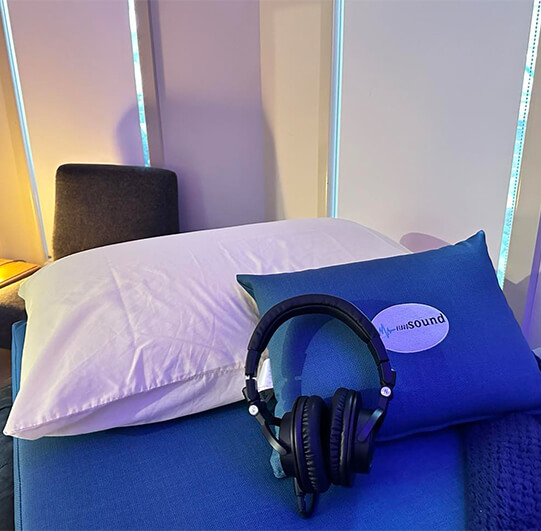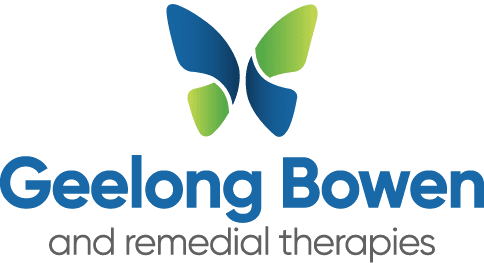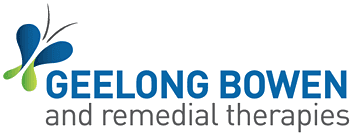Vibroacoustic therapy (VAT) is a non-invasive form of therapy that uses frequencies, sound and vibration to promote relaxation, reduce pain, and improve physical and emotional well-being. It is based on the science in physics that sound waves and vibration can have a therapeutic effect on the body, mind, and spirit.
Vibroacoustic therapy involves lying on a special lounge which contains transducers that emit low-frequency sound waves and vibrations. The sound and vibration are synchronized with specially composed calming music to create a deeply relaxing and meditative experience. The frequency and intensity of the sound and vibration can be adjusted to target specific areas of the body or to address specific health concerns.
The therapeutic effects of vibroacoustic therapy are thought to be due to its ability to stimulate the body’s natural relaxation response, increase blood flow and lymphatic drainage, reduce muscle tension and pain, and promote the release of endorphins, which are natural painkillers. The combination of tactile sensations from the vibrations and auditory stimulation from the sound enhances the therapeutic effect. The vibrations are typically administered at frequencies ranging from 30 to 120 Hz, which correspond to the range of natural bodily frequencies.

Vibroacoustic therapy may be used to treat a wide range of health conditions, including chronic pain, stress, anxiety, depression, sleep disorders, ADHD, ADD and autism spectrum symptoms. It is safe and non-invasive, although it is not used during pregnancy or with certain medical conditions.
How does music as sound and vibration impact your body and brain
Dr. Lee Bartel explores how sound can stimulate cells in your body and brain to reduce the impact of Fibromyalgia pain, Alzheimer’s Disease, Parkinson’s Disease, Depression, and even increase blood flow.
It shows how a vibroacoustic therapy is used to treat these health conditions.”
What can I expect in a Vibroacoustic Therapy session?
So glad you asked:
At the start of your Vibroacoustic Therapy, you will get the chance to be comfortable by removing your shoes, smart watch, earrings if any, and turn your phone to aeroplane mode. The room is darkened.
Once ready, you will lay down on our treatment table and made comfortable. A team member will then choose the music (which you will hear through a headset) and frequencies to target your noted issues.
With the machine turned on, you will start to feel a gentle vibration through the mattress. You will also hear soothing music coming from your headset. Our team member will leave you alone to enjoy your session in the room. This can last between 25 to 45 minutes.
You may begin to experience a number of pleasant sensations. Your abstract thinking may slow, while the awareness of your body and mind may expand. You may also experience going into a deep meditative or dream-like state, possibly even falling asleep. You may start to experience a level of clarity or insight. Each person’s experience is different and your response may vary each time.
Once the session has ended, we will return and will assist you off the treatment table if required.
What is it for?
Vibroacoustic therapy (VAT), uses pulsed, sinusoidal, low-frequency sound on a specially designed lounge. (1)
On the basis of clinical experience and case reports, the most promising areas for the use of VAT seem to be applications for muscle tension and spasticity, acute and chronic pain (eg, neck tension, menstrual pain, fibromyalgia), and psychosomatic and stress-related symptoms (eg, high physiological arousal ,mood disorders, insomnia). (1)
Research
There have been many studies on the health effects of vibroacoustic therapy (VAT). Here are a few examples of research on health and VAT:
Pain relief: A systematic review of the literature published in 2019 found that VAT may be effective in reducing pain and improving quality of life in patients with chronic pain conditions, such as fibromyalgia, low back pain, and osteoarthritis.(2)(5)
Stress reduction: One randomized controlled trial published in 2017 found that VAT was effective in reducing stress and improving well-being in healthy adults. The study also found that the effects of VAT lasted up to four weeks after the therapy. Another found “Vibroacoustic therapy has the potential to contribute to the stress management of university students, as well to the general population with heightened stress response and its general impact on health. This trial proved that LFS has some effect on the parasympathetic nervous system.” (4)
Sleep improvement: A pilot study published in 2017 found that VAT was effective in improving sleep quality and reducing symptoms of insomnia in adults with sleep disturbances.
Autism: A randomized controlled trial published in 2014 found that VAT was effective in improving sensory processing and reducing anxiety in children with autism spectrum disorder.
Overall, a growing number of studies suggest that VAT may have potential health benefits in a range of conditions, including chronic pain, stress, sleep disturbances, ASD, Parkinsons and dementia. However, more research is needed to fully understand the mechanisms of action and to determine the optimal parameters for VAT.
- Punkanen, Marko & Ala-Ruona, Esa. (2012). Contemporary Vibroacoustic Therapy Perspectives on Clinical Practice, Research, and Training. Music and Medicine. 4. 128-135. 10.1177/1943862112445324.
- Elsa A. Campbell, Jouko Hynynen, Birgitta Burger & Esa Ala-Ruona (2019) Exploring the use of Vibroacoustic treatment for managing chronic pain and comorbid mood disorders: A mixed methods study, Nordic Journal of Music Therapy, 28:4, 291-314, DOI: 10.1080/08098131.2019.1604565
- Rüütel, Eha. (2009). The Psychophysiological Effects of Music and Vibroacoustic Stimulation. Nordic Journal of Music Therapy. 2002. 16-26. 10.1080/08098130209478039.
- Kantor, J., Vilímek, Z., Vítězník, M., Smrčka, P., Campbell, E. A., Bucharová, M., … Kantorová, L. (2022). Effect of low frequency sound vibration on acute stress response in university students—Pilot randomized controlled trial. Frontiers in Psychology, 13. https://doi.org/10.3389/fpsyg.2022.980756
- Loewy J. (2022). Underlying Music Mechanisms Influencing the Neurology of Pain: An Integrative Model. Brain sciences, 12(10), 1317. https://doi.org/10.3390/brainsci12101317
What are our clients saying?
“Having experienced this last week, what a great experience and a great way to relax and start a weekend. I had a 30 min session but will be going back for an hour as it helped with my sleeping.” Skye B.
Benefits
Pain Reduction and Management
Research has indicated that VAT can effectively reduce pain levels in individuals with various conditions, including fibromyalgia, chronic pain, and musculoskeletal disorders. The vibrational stimulation provided by VAT has been shown to alleviate pain and improve overall comfort.
Stress and Anxiety Reduction
Studies have demonstrated that VAT can lead to significant reductions in stress and anxiety. The soothing vibrations and sound frequencies used in VAT contribute to relaxation, helping individuals achieve a more calm and centred state of mind.
Improved Sleep Quality
VAT has been associated with improved sleep patterns and enhanced sleep quality. The therapy's calming effects on the nervous system contribute to better sleep initiation and maintenance, especially in individuals with sleep disorders.
Enhanced Mood and Emotional Well-being
Research suggests that VAT has the potential to elevate mood and promote emotional well-being. The combination of sound vibrations and music can positively impact neurotransmitter levels, fostering a sense of joy and tranquillity.
Muscle Relaxation and Tension Relief
VAT's vibrational stimulation has been linked to muscle relaxation and tension relief. It can help reduce muscle stiffness and discomfort, making it beneficial for individuals with conditions such as muscle spasms or tension headaches.
Improved Circulation and Blood Flow
Vibrational therapy, a core component of VAT, has been found to enhance circulation and blood flow. This can contribute to better oxygen and nutrient delivery to cells, supporting overall tissue health.
Enhanced Cognitive Function
Some studies suggest that VAT may have a positive impact on cognitive function. The combination of auditory and vibrational stimuli has been shown to enhance focus, attention, and cognitive processing.

